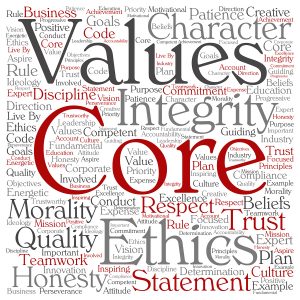Things Bosses Believe About Employee Engagement That Are Flat Out Wrong
 There are some who readily embrace the concept of how critical employee engagement is to a productive workplace. Others have to first overcome some hurdles.
There are some who readily embrace the concept of how critical employee engagement is to a productive workplace. Others have to first overcome some hurdles.
I hear it often – perhaps you have heard it too. Sometimes from “old school management” fans or simply those who refuse to let go of preconceived notions.
What holds them back are firmly held beliefs that, despite research proving them wrong, they refuse to release because it is all they know. It is myths about behaviors or people or management concepts that hold them back.
Here are some of the key myths.
Mindset or Culture Employee Engagement Myths
People Don’t Engage Because They Are Lazy
Lazy is a descriptive term we apply to someone who isn’t getting the work done. Yet in a article in Psychology Today, Laura Miller says that the problem is more avoidance behavior. In other words, some emotional issue is keeping them from taking action. She cites seven things that may be the real cause of an employee not getting the job done:
- Fear of Failure – Better to not try than to fail
- Fear of Success – What happens to my life if I succeed?
- Desire for Nurture – No one pays attention unless I mess up
- Fear of Expectations – If I do well, will the boss pile up the work?
- Passive-aggressive Communication – Avoid conflict, just do nothing
- Need for Relaxation – I really just need a rest
- Depression – I have a real problem here
Some of these are rare, some not as rare as you might think. If an employee is not getting work done, you can be assured there is an issue and it’s not their work ethic.
That Generation Just Wants It All Handed To Them
This is typically targeted primarily at “Millennials” and sometimes at Generation X, the one before them. Millennials were born from 1982 to 2004, meaning some Millennials are in their lower 30’s now. Many believe them to be a lazy generation – that they just don’t want to work. Also that Millennials are so self-absorbed that they can’t fully engage at work.
In truth, most Millennials love to work!
They are passionate about achievement and significance.
What is different is how they get there. They want to be free to get to the end result their own way.
And they DO get results. They just don’t see the value of showing up just to show up.
“Those People” Just Don’t Work Hard
Some believe that specific ethnic cultures or impoverished cultures are naturally prone to avoid work or are too wrapped up in their families to be fully engaged.
Yet research by census and the Pew Research Center suggest otherwise, indicating they are no less engaged than any other ethnicity or social status.
Myths About Employee Engagement That Block Progress
Employee Engagement Should Be Checked Annually
Many organizations rely on the annual employee survey. With the trend emphasizing employee engagement, most have taken that survey and renamed it to the Employee Engagement Survey. Problem is, all they changed was the name. I wrote in detail about that in my blog Six Reasons Your Employee Engagement Survey Fails and What You Can Do About It.
The real test of engagement is ongoing and targeted. It’s also personal. Sending out a survey once a year, which gets about 10% response in a good year, doesn’t give you the real pulse. Neither does an annual employee review, which is typically one-sided. To get the real feel for where you are, you need to tap into the line managers and individual contributors frequently.
Sam Walton (Walmart) was famous for this. He would fly into a warehouse location or store location, hop into the passenger seat of one of trucks, and ride around and talk to the driver. He learned about what they felt, how things were going, and what they could do better. And he showed employees he cared about what THEY feel.
Employee Engagement Can Be Bought
This one just doesn’t seem to want to go away. It comes mostly from the sales angle, particularly among managers who believe that salespeople are entirely driven by money. They believe if they just create opportunities for more income then that’s all the incentive they need to engage people more. Maybe it works short-term for one person, but generally fails with the rest. It is then explained away as being the fault of the employees and not the program.
Surveys conducted on sales staff and other groups repeatedly show that money is not the primary motivator. In fact, it’s not usually in the top three.
Another way that managers attempt to buy engagement is by adding workplace features. It’s kind of like someone who tries to buy your love by constantly giving you things. Doesn’t work in personal relationships either.
There is a Standard Solution to Employee Engagement
This myth is perpetuated mostly by companies that want to sell you a solution.
This engagement survey will fix it. This software program provides the metrics you need. Purchase this benefits program. Buy the secret to our proprietary system that solves employee engagement forever!
That works if your organization is just like every other organization and your employees are like everyone else. You and I know that’s not true.
Your situation is unique. It requires an innovative approach that is entirely yours.
It is highly unlikely you will be able to develop that on your own. You are too close to the equation. The right coach can help.
Employee Engagement is the End Game
Finally, it’s important to remember that our real goal here isn’t employee engagement. Our real goal is have one or all of these things:
- A supremely productive workplace
- Cohesive teams
- Strong leadership
- Reduced turnover
- Higher customer satisfaction
- Increased profits
Employee Engagement is a means to the end. You can’t have greater productivity without more engagement. And you haven’t really engaged them if they aren’t becoming more productive. It’s a symbiotic relationship.
Anything else is not productive.




